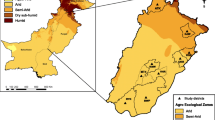Abstract
The paper provides a summary of three studies conducted in the eastern Free State of South Africa between 1998 and 2000. In a questionnaire-based study approximately 21% of interviewed resource-poor farmers (n = 150) indicated that they experienced problems with ticks and tick-borne diseases. About 56% of farmers indicated that tick-related problems were most severe in summer, while 32% indicated that the most problems were encountered in winter. About 12% indicated that the tick problems were experienced throughout the year. Farmers also indicated that the highest tick burdens were experienced between spring and early winter. The principal ticks infesting cattle (n = 30) were found to be Boophilus decoloratus (53.1%), Rhipicephalus evertsi evertsi (44.7%), Rhipicephalus follis (1.0%), Rhipicephalus gertrudae (0.7%) and Rhipicephalus warburtoni (0.4%). On small stock (n = 188), R. evertsi evertsi (68%) and B. decoloratus (32%) were recorded as the main ticks in the study area. A sero-epidemiological survey of cattle (n = 386) showed that 94% of cattle were sero-positive for Babesia bigemina by IFAT, while 87% were sero-positive for Anaplasma by indirect ELISA. All the animals were sero-negative for Babesia bovis and this is probably because the tick vector, Boophilus microplus, is not present in the study area. All sheep and goats were sero-positive for Theileria species by IFAT while 85% of sheep and 100% of goats tested positive for Anaplasma species by competition inhibition ELISA. The high incidence of positive serological results for B. bigemina and Anaplasma in cattle, and Theileria and Anaplasma in sheep and goats and the absence of clinical cases would indicate that this area is endemically stable for these diseases.
Similar content being viewed by others
References
Alexander, R.A. 1931. Heartwater, the present state of our knowledge of the disease. Seventeenth Report of the Director of Veterinary Services and Animal Industry, Union of South Africa, pp. 89-150.
Hlatshwayo, M., Mbati, P.A. and Dipeolu, O.O. 2002. Seasonal abundance of adult ixodid ticks infesting cattle belonging to resource-limited farmers in the north-eastern Free State Province of South Africa. Onderstepoort J. Vet. Res. 69: 1-6.
Jansen, B.C. and Neitz, W.O. 1956. The experimental transmission of Theileria ovis by Rhipicephalus evertsi. Onderstepoort J. Vet. Res. 27: 3-6.
Moffett, O.R. 1997. Grasses of the eastern Free State: their descriptions and uses. University of the North, Qwa-Qwa Campus, Phuthaditjhaba, pp. 13-14.
Morzaria, S.P., Brocklesby, D.W. and Harradine, D.L. 1977. Evaluation of the indirect flourescent antibody test for Babesia major and Theileria mutans in Britain. Vet. Rec. 100: 484-487.
Norval, R.A.I., Fivaz, B.H., Lawrence, J.A. and Daillecourt, T. 1983. Epidemiology of tickborne diseases of cattle in Zimbabwe. I. Babesiosis. Trop. Anim. Hlth. Prod. 15: 87-94.
Norval, R.A.I., Barrett, J.C., Perry, B.D. and Mukhebi, A.W. 1992. Economics, epidemiology and ecology: a multidisciplinary approach to the planning and appraisal of tick and tickborne disease control in Southern Africa. In: Tick Vector Biology: Medical and Veterinary Aspects, B. Fivaz, T. Petney and I.G. Horak (eds), pp. 35-54. Springer, Berlin.
Potgieter, F.T. 1977. The life-cycle of Babesia bovis and Babesia bigemina in ticks and in cattle in South Africa. PhD Thesis, Rand Afrikaans University, Auckland Park, South Africa.
Potgieter, F.T. and Els, H.J. 1977. Light and electron microscope observations on the development of Babesia bigemina in larvae, nymphae and non-replete females of Boophilus decoloratus. Onderstepoort J. Vet. Res. 44: 213-232.
Potgieter, F.T. and Van Rensburg, 1987. Tick transmission of Anaplasma centrale. Onderstepoort J. Vet. Res. 54: 5-7.
Potgieter, F.T. and Stoltsz, W.H. 1994. Bovine anaplasmosis. In: Infectious Diseases of Livestock with Special Reference to Southern Africa, J.A.W. Coetzer, G.R. Thompson and R.C. Tustin (eds), pp. 408-414. Oxford University Press, Cape Town.
Riek, R.F. 1964. The life cycle of Babesia bigemina (Smith and Kilbourne, 1893) in the tick vector Boophilus microplus (Canestrini). Aust. J. Agric. Res. 15: 802-821.
Uilenberg, G. 1981. Theilerial species of domestic livestock. In: Advances in the Control of Theileriosis, A.D. Irvin, M.P. Cunningham and A.S. Young (eds), pp. 4-37. Martinus Nijhoff.
Visser, E.S., McGuire, T.C., Palmer, G.H., Davis, W.C., Shkap, V., Pipano and Knowles, D.P. 1992. The Anaplasma marginale msp5 gene encodes a 19 kDa protein conserved in all recognized Anaplasma species. Infect. Immun. 60: 5139-5144.
Walker, J.B. 1961. Some observations on the classification and biology of ticks belonging to the genus Rhipicephalus with special reference to the immature stage. East Afr. Med. J. 38: 232-246.
Author information
Authors and Affiliations
Rights and permissions
About this article
Cite this article
Mbati, P.A., Hlatshwayo, M., Mtshali, M.S. et al. Ticks and Tick-Borne Diseases of Livestock Belonging to Resource-poor Farmers in the Eastern Free State of South Africa. Exp Appl Acarol 28, 217–224 (2002). https://doi.org/10.1023/A:1025306701803
Issue Date:
DOI: https://doi.org/10.1023/A:1025306701803




